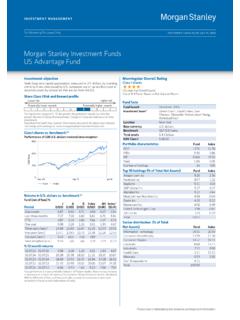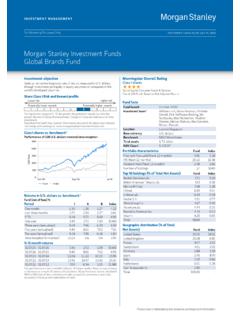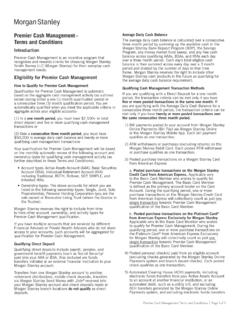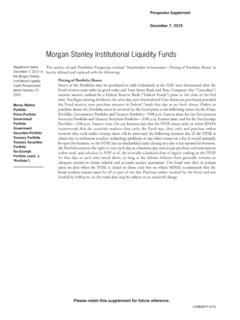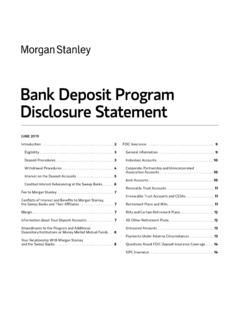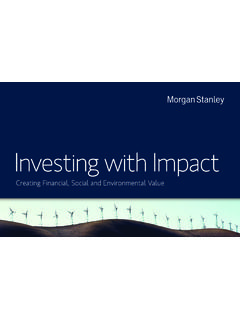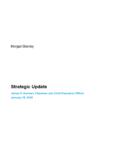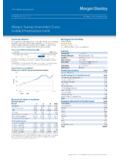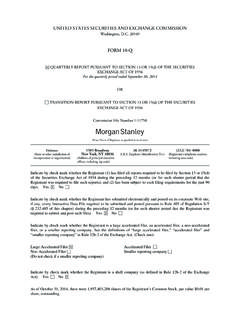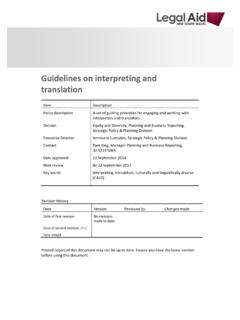Transcription of High-Yield Bonds in Rising Rates - Morgan Stanley
1 PORTFOLIO MANAGERRICHARD LINDQUISTM anaging Director high yield Fixed Income TeamHigh- yield Bonds in Rising RatesFIXED INCOME | GLOBAL FIXED INCOME | INVESTMENT INSIGHT | 2017It s high yield and not high quality that tends to perform better in the bond markets as Rates start to rise, says Morgan Stanley s Richard Lindquist. There are times when it might not pay to play it safe in the bond market, and one of those times is now, according to Richard Lindquist, a senior High-Yield bond fund manager at Morgan Stanley Investment the Federal Reserve hikes Rates , it s the lower-quality Bonds that tend to be the better-performing, fixed income assets, he argues, and that s already evident. Since Donald Trump was elected in early November, Treasury Bonds have suffered a dramatic sell-off, in anticipation that his fiscal spending plans will prompt more Fed rate hikes next November 8 and December 31, 2016, Treasuries in aggregate have returned , and investment-grade Bonds have returned High-Yield Bonds , meanwhile, have returned And within the High-Yield market, it s the Bonds on the lowest rung of the rating ladder the single-B and triple-C names that have performed the If you are going to be in fixed income, then I believe the High-Yield market will be one of the better places to be, and within that, the lower-rated credits, argues Lindquist.
2 High-Yield Bonds feel the impact of Rising Rates like other higher-quality Bonds , but usually less so. That s largely because they re more influenced by the equity markets; their maturities are shorter and their coupons higher, says Treasury Aggregate; IG: Bloomberg Barclays Corporate Index; HY: Bloomberg Barclays Corporate high yield INSIGHTMORGAN Stanley INVESTMENT MANAGEMENT | FIXED INCOMEThe Equity FactorHigh- yield corporate Bonds tend to see the initial round of rate hikes as a good thing, because it s an improving economy that prompts them. After the election, we saw much of the sector-based rotation occurring in the equity market spill over to our market, says Jack Cimarosa, a senior member on Lindquist s team. Rentals, construction and basically anything tied to infrastructure traded well. The Shorter, the BetterThe longer a bond s maturity date, or duration, the more sensitive it is to rate moves. High-Yield companies generally have shorter maturities than their higher-quality competitors.
3 The duration of the Bloomberg Barclays Corporate High-Yield Index is years, for instance, compared with years for the Bloomberg Barclays Investment Grade Corporate Potential for IncomeHaving a high yield means a higher coupon or interest payment. Since total returns are the price moves of a bond plus coupon payments, then the higher the coupon, the more able the bond is to absorb any decline in dollar price caused by a rate hike. The Corporate high yield Index s yield is around , versus for the Barclays Investment Grade Down the Rating LadderTo get the bigger coupons, Lindquist s team focuses on the middle market companies with $150 million to $1 billion in total debt. These companies are smaller and their Bonds less traded than bigger deals, but they offer better yield . The rating agencies falsely, we believe give credit for size, so middle-market Bonds are always slightly lower-rated than we feel they should be, says Lindquist.
4 He also prefers to overweight the lowest-rated parts of the market single-B and triple-C names where the yields are highest. Going into weaker credits would be a harder decision to make if defaults were Rising , but we believe defaults will be contained, and might even fall over the next six to 12 months, he says. The entire High-Yield market s default rate is around , but just if energy, metals and mining sectors are stripped Date: As of December 31, As of December 31, Moody s Investors Service, as of December 31, 1 Attractive Yields with Low Duration0%8% HighYieldEuropeanHigh to Worst* (YTW) per Unit of YTW Duration in Years YTW per Unit of * yield to Worst is the lowest yield an investor can expect when investing in a callable bond . A callable bond is one which gives the issuer the option to redeem the bond at a set date before : Bloomberg Barclays Capital and JP Morgan Past performance is not indicative of future results.
5 The indexes are provided for informational purposes only and are not intended to predict or represent the performance of any Morgan Stanley investment or strategy. In general, fixed income investments are subject to credit and interest rate risks. High-Yield investments may have a higher degree of credit and liquidity risk. Foreign securities are subject to currency, political, economic and market risks. For more information, please refer to the IMPORTANT DISCLOSURES Bonds IN Rising RATESFIXED INCOME | Morgan Stanley INVESTMENT MANAGEMENTIMPORTANT DISCLOSURESThis material is for use of Professional Clients only, except in the where the material may be redistributed to or used with the general views and opinions forecasts and estimates expressed are those of the speaker as of the date of publication and are subject to change at any time due to market or economic conditions and may not necessarily come to pass. Furthermore, the views will not be updated or otherwise revised to reflect information that subsequently becomes available or circumstances existing, or changes occurring, after the date of the interview.
6 The views expressed do not reflect the opinions of all portfolio managers at Morgan Stanley Investment Management (MSIM) or the views of the firm as a whole, and may not be reflected in all the strategies and products that the Firm and/or estimates provided herein are subject to change and may not actually come to pass. Information regarding expected market returns and market outlooks is based on the research, analysis and opinions of the authors. These conclusions are speculative in nature, may not come to pass and are not intended to predict the future performance of any specific Morgan Stanley Investment Management information provided has been prepared solely for informational purposes and does not constitute an offer or a recommendation to buy or sell any particular security or to adopt any specific investment strategy. The information herein has not been based on a consideration of any individual investor circumstances and is not investment advice, nor should it be construed in any way as tax, accounting, legal or regulatory advice.
7 In addition, this material is not an offer, or a solicitation of an offer, to buy or sell any security or instrument or to participate in any trading and graphs provided herein are for illustrative purposes only. Past performance is no guarantee of future CONSIDERATIONST here is no assurance that a Portfolio will achieve its investment objective. Portfolios are subject to market risk, which is the possibility that the market values of securities owned by the Portfolio will decline and that the value of Portfolio shares may therefore be less than what you paid for them. Accordingly, you can lose money investing in this Portfolio. Please be aware that this Portfolio may be subject to certain additional risks. Fixed income securities are subject to the ability of an issuer to make timely principal and interest payments (credit risk), changes in interest Rates (interest rate risk), the creditworthiness of the issuer and general market liquidity (market risk).
8 In the current Rising interest rate environment, bond prices may fall and may result in periods of volatility and increased portfolio redemptions. Longer-term securities may be more sensitive to interest rate changes. In a declining interest rate environment, the Portfolio may generate less income. High-Yield securities ( junk Bonds ) are lower-rated securities that may have a higher degree of credit and liquidity risk. Public bank loans are subject to liquidity risk and the credit risks of lower-rated securities. In general, equity securities values also fluctuate in response to activities specific to a company. The strategy may invest in restricted and illiquid securities, which may be difficult for the strategy to sell at a reasonable price (liquidity risk). Derivative instruments may disproportionately increase losses and have a significant impact on performance. They also may be subject to counterparty, liquidity, valuation, correlation and market risks.
9 Distressed and defaulted securities are speculative and involve substantial risks in addition to the risks of investing in junk Bonds . The Portfolio will generally not receive interest payments on the distressed securities and the principal may also be at risk. These securities may present a substantial risk of default or may be in default at the time of investment, requiring the Portfolio to incur additional costs. Preferred securities are subject to interest rate risk and generally decrease in value if interest Rates rise and increase in value if interest Rates fall. Mezzanine investments are subordinated debt securities, thus they carry the risk that the issuer will not be able to meet its obligations and they may lose value. Foreign securities are subject to currency, political, economic and market risks. The risks of investing in emerging market countries are greater than the risks associated with investments in foreign developed Bloomberg Barclays Corporate high yield Index measures the market of USD-denominated, non-investment grade, fixed-rate, taxable corporate Bonds .
10 Securities are classified as high yield if the middle rating of Moody s, Fitch and S&P is Ba1/BB+/BB+ or below. The index excludes emerging market debt. The Bloomberg Barclays Pan-European high yield Index covers the universe of fixed-rate, sub-investment-grade debt denominated in euros or other European currencies (except Swiss francs). This index includes only euro- and sterling-denominated Bonds , because no issues in the other European currencies now meet all the index requirements. To be included, the Bonds must be rated High-Yield (Ba1/BB+ or lower) by at least two of the following ratings agencies: Moody s, S&P, Fitch. If only two of the three agencies rate the security, the lower rating is used to determine index eligibility. If only one of the three agencies Rates a security, the rating must be High-Yield . Bonds must have at least one year to maturity and an outstanding par value of at least 50 million euros. The index does not include nonrated Bonds , and it excludes debt from entities in countries that are designated as emerging JP Morgan Emerging Markets bond Index Global (EMBI Global) tracks total returns for traded external debt instruments in the emerging markets, and is an expanded version of the EMBI+.
